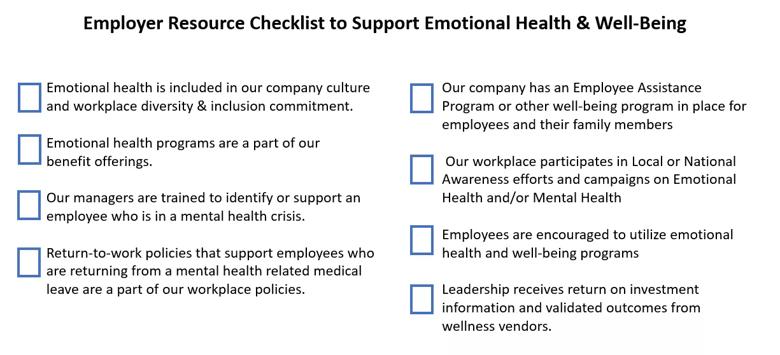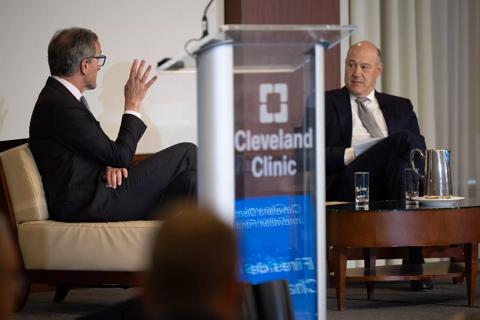How employers can support their employees’ well-being

As our people return to work, empathetic leaders who focus on emotional wellbeing and safety are striving to keep their employees performing at their best. There are several benefits when wellness efforts focus on building a culture of wellbeing in addition to traditional elements of physical health and disease prevention. Regina Chandler, Executive Director, Workplace Wellness, believes employees can develop their full potential when the organization encourages activation of culturally relevant, evidence-based tools and resources focused on the whole person—the body, emotions, mind and spirit—in its ongoing engagement strategy. This engagement builds a workplace that fosters a healthy relationship with self, and with family, both inside and outside of the organization, creating a culture of wellbeing.
Advertisement
Cleveland Clinic is a non-profit academic medical center. Advertising on our site helps support our mission. We do not endorse non-Cleveland Clinic products or services. Policy
“Our well-being strategy is grounded by our strategic direction and priorities: Care for the Patient, Care for the Caregiver, Care for the Organization and Care for the Community. As we Care for the Caregiver, we are guided by the expertise of our clinical leadership. One such leader is Amy Freadling, PhD, who heads up our Caring for Caregivers program,” says Chandler.
Dr. Freadling advises, “During a time when circumstances are clearly unnatural, we emphasize with our leaders that there may be times when employees, colleagues and customers act in a way that’s a little different than the norm. They may be on edge or not as productive as they once were. It’s important to check-in and ask simple questions like ‘How are you doing?’ and ‘What do you need right now?’ This is a time to truly exercise empathy and to support your business whether in employee morale or customer service. Not just talking the talk, but walking the walk and showing by example.”
Many caregivers have been working safely in clinical settings since the outset of the pandemic, and a large segment have been navigating a new dynamic by working from home. Whether on-site in a clinic facility or remote, all employees can be supported by a broad offering of assistance:
These services have seen exponential growth in recent months demonstrating that caregivers are getting access to the resources that help them perform at full potential. It is important to be more aware of the resources available through the company’s EAP and leverage their services to the fullest.
Advertisement
Employers know that emotional well-being is a priority but they don’t know how to address this topic. They do not feel prepared or confident in doing so. When employees are given the tools and support for emotional well-being, they are more productive, they miss less work and they are far more engaged in the workplace.
According to the Society for Human Resource Management (SHRM), “The Total Financial Impact of Employee Absences Survey,” produced in collaboration with and commissioned by Kronos Incorporated, absenteeism has a significant impact on organizations. The study reports that some organizations may be able to reduce absences by implementing wellness programs that help employees deal with health issues and stress. More than two-thirds (69%) of respondents indicated unplanned absences add to the workload; about three-fifths said these types of absences increase stress (61%) and disrupt the work of others (59%), and almost half (48%) reported unplanned absences hurt morale.
From the emotional well-being perspective, the pandemic is going to be a long-term disruptor in our society that will need to be addressed, especially for workplaces. Many employees are fearful about returning to work. Employers are finding themselves looking for resources to help ensure that they are bringing back workers safely. And that includes supporting their emotional well-being to optimize their ability to perform well.
Without a doubt, uncertainty about the prevalence of the disease plays on the minds of workers. According to Anxiety & Depression Society of America (ADSA) “anxiety disorders are the most common mental illness in the U.S., affecting 40 million adults in the United States age 18 and older, or 18.1% of the population every year.” Current scenarios, which are clearly unnatural, means this figure is being exacerbated in ways still being discerned.
Advertisement
Chandler reflects on Cleveland Clinic programs utilized to support resiliency, “For years we’ve been partnering directly with employers to develop innovative programs to better their employees’ health. We serve our employer stakeholders through Cleveland Clinic AtWork by offering an umbrella of health and wellness services for organizations from manufacturers to retailers. These are proven solutions that help manage overall health including dealing with stress to remain resilient.
“A couple of years ago we started thinking about how we could support employees that were experiencing a level of anxiety that impacted their emotional well-being, but that didn’t require the services of the employee assistance program or a clinical visit. What quickly became a reality is a new program we developed called Clarity – an evidenced-based, four-month, skill-building and coaching program that focuses on helping individuals build and maintain overall emotional health and well-being. Clarity was launched just prior to the onset of COVID-19, and thankfully so.”
Clarity’s timely development has been instrumental in helping employees manage change during this extraordinary period of history. What distinguishes Clarity is that it is the only e-coaching program focused on overall emotional well-being. It is uniquely different program and modality from the work of EAP and clinical counseling. Coaching goals are centered on action, accountability, and follow-through.
Some of the most common work is around stress management skills, coping strategies and problem-solving. The Clarity program offers participants strategies and skill-building tasks to practice these concepts to maximize behavior change.
Advertisement
Eva Steinel, LPCC-S, Department Manager, Behavioral Health Programming, encourages organizations to examine how they are addressing the emotional well-being needs of their employees by reviewing a few questions about their current offering, “Start by asking yourself this question: ‘Where does my organization stand?’” For a check-in, the following checklist provides some guidance, see graphic 1.

Graphic 1
Steinel reflects on the data that demonstrate the usefulness to employees, “There are several themes becoming evident with participants in the Clarity program. Stress and uncertainty are at an all-time high. Many individuals are struggling with the decision to send kids back to school or keep them home for remote schooling. Either decision is stirring up feelings of doubt. We’re also seeing marital strain during COVID. We’ve added a variety of resources to help with these struggles, normalize experiences, and continue to support through the coaching relationship.”
Focusing on emotional well-being allows organizations to assist individuals as they realize their abilities, cope with the normal stresses of life, to work productively and have the ability to make a contribution to their communities. Online resources facilitate remote or distributed work, especially in light of limited time and concern about being at risk of compromised health.
Chandler reports that there is growing interest in the Clarity program as it is building momentum with employer clients. The program fills a gap and complements employee assistance programs. She reports, “For those taking the program, reductions in worry, unhappiness, and overall stress are documented utilizing a series of validated measures to assess stress, emotional well-being, and workplace performance, as well as improvements in mood, absenteeism and concentration. As we continue to grow and measure outcomes in a larger population we will look to publish results.”
Advertisement
Leadership programs developed by Cleveland Clinic encourage innovation and create projects that have positive institutional impact. For more information on Cleveland Clinic Global Executive Education contact the team online at clevelandclinic.org/execed.
Absenteeism
https://www.shrm.org/hr-today/news/hr-magazine/documents/kronos_us_executive_summary_final.pdf
Anxiety
https://adaa.org/about-adaa/press-room/facts-statistics
Advertisement

Cleveland Clinic partners with Palantir to create logistical command center

How our multifaceted Hero Experience Program is a win for all involved

Training, resources help with meaningful palliative care conversations

How a standardized checklist is guiding us to fewer safety events

How holding simulations in clinical settings can improve workflow and identify latent operational threats

Interactive Zen Quest experience helps promote relaxing behaviors

Cleveland Clinic and IBM leaders share insights, concerns, optimism about impacts

A Q&A with organizational development researcher Gina Thoebes